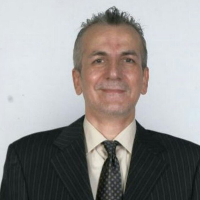Motion Correction in Myocardial SPECT Imaging Using Polynomial Curve Modeling
Author(s):
Abstract:
Background and
Purpose
Patient motion during myocardial perfusion SPECT can produce artifacts in reconstructed images which might affect clinical diagnosis. This paper attempts to present a new approach for the detection and correction of cardiac motion utilizing the data obtained during the imaging process. Materials And Methods
Our method quantifies motion through polynomial curves modeling onto the 1D vectors corresponding to image frames obtained in summed profiles. To evaluate our method, physical sources and NCAT phantom were intentionally moved 1, 2 and 3 pixels at early, mid and late stages of data acquisition. The full width at half maximum (FWHM) values, the maximum count in the reconstructed image of physical sources, and maximum count in the myocardial wall in 360o view from cardiac perspective were compared with motion-free condition before and after motion correction. Results
Depending on the amount of motion and time of motion occurrence, the FWHM of point source changed from 5.56% to 37.49% compared to the motion-free condition while the relative change of FWHM for these sources changed from 0.8% to 1.84% after correction. The observed changes for maximum count in reconstructed images of point sources were from 1.91% - 21.33% which decreased to 0.13%-0.76% after motion correction. The corresponding changes for extended sources were 1.09%- 21.76% which reduced to 0.06%-0.45% after applying motion correction. In addition, the results showed that the distribution of radioactivity in the cardiac wall for the corrected image are very similar to the real values while the same values in the reconstructed image significantly differed from the original in which motion occurred during imaging. Conclusion
Our method detected and corrected cardiac motion during SPECT imaging through curve fitting of a polynomial onto the 1D vector values corresponding to image frames. Therefore, image misinterpretation can be avoided by correcting motion artifacts.Keywords:
Language:
Persian
Published:
Journal of Mazandaran University of Medical Sciences, Volume:22 Issue: 96, 2013
Pages:
9 to 20
magiran.com/p1233045
دانلود و مطالعه متن این مقاله با یکی از روشهای زیر امکان پذیر است:
اشتراک شخصی
با عضویت و پرداخت آنلاین حق اشتراک یکساله به مبلغ 1,390,000ريال میتوانید 70 عنوان مطلب دانلود کنید!
اشتراک سازمانی
به کتابخانه دانشگاه یا محل کار خود پیشنهاد کنید تا اشتراک سازمانی این پایگاه را برای دسترسی نامحدود همه کاربران به متن مطالب تهیه نمایند!
توجه!
- حق عضویت دریافتی صرف حمایت از نشریات عضو و نگهداری، تکمیل و توسعه مگیران میشود.
- پرداخت حق اشتراک و دانلود مقالات اجازه بازنشر آن در سایر رسانههای چاپی و دیجیتال را به کاربر نمیدهد.
In order to view content subscription is required
Personal subscription
Subscribe magiran.com for 70 € euros via PayPal and download 70 articles during a year.
Organization subscription
Please contact us to subscribe your university or library for unlimited access!


